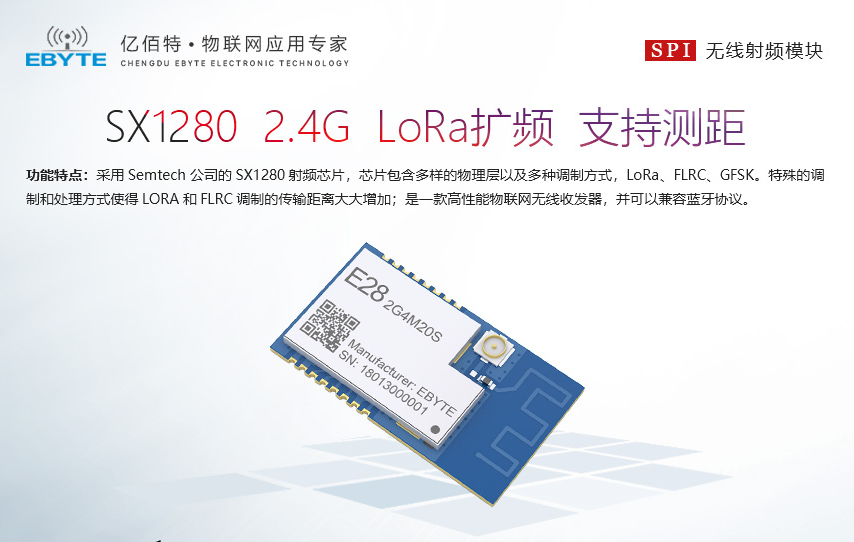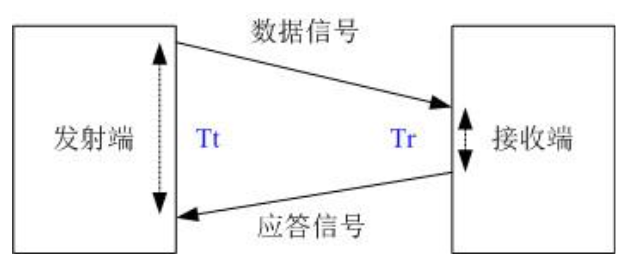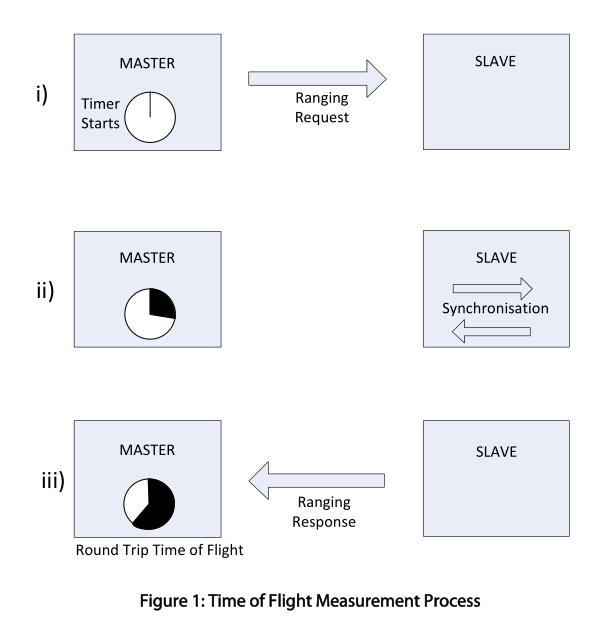
The E28 series is a 2.4GHz RF transceiver module designed and manufactured by Chengdu Ebyte Electronic Technology Co., Ltd., with long communication distance; it has extremely low power consumption in low power mode. This series comes with a high performance PCB onboard antenna.
The E28 series uses Semtech's SX1280 RF chip, which contains a variety of physical layers and a variety of modulation methods, such as LORA, FLRC, GFSK. The special modulation and processing method makes the transmission distance of LORA and FLRC modulation greatly increased; it is a high-performance IoT wireless transceiver and is compatible with the Bluetooth protocol. Excellent low-power performance, on-chip DC-DC and Time-of-flight make this chip powerful for smart homes, security systems, location tracking, wireless ranging, wearables, smart bracelets and health management, etc. . The SX1280 supports RSSI, allowing users to achieve deep secondary development as needed; the SX1280 also integrates time-of-flight for distance measurement.

Features: Adopted Semtech's SX1280 RF chip, the chip contains a variety of physical layers and a variety of modulation methods, LoRa, FLRC, GFSK. Special modulation and processing methods make the transmission distance of LoRa and FLRC modulation greatly increased; it is a high-performance IoT wireless transceiver and is compatible with the Bluetooth protocol.
Briefly introduce the TOF (time-of-flight) ranging method of time-of-flight ranging method:
The method is a two-way ranging technique that uses the time of flight of a data signal between a pair of transceivers to measure the distance between two points. The time interval between transmitting the data signal from the transmitting end and receiving the response signal from the receiving end is recorded as Tt, and the time interval at which the receiving end receives the data signal of the transmitting end and the response signal is recorded as Tr, as shown in the following figure. The one-way time of flight Tf = (Tt - Tr) / 2 between the pair of transceivers, the distance d = c * Tf between the two points, where c represents the electromagnetic wave propagation speed.

Figure 1 time-of-flight ranging method
Transmitting end: Data signal: Receiving end: Acknowledge signal
Then is the SX1280 ranging function details:
The ranging function of the SX1280 is based on measuring the round-trip flight time between a pair of SX1280 transceivers. This process USES the LoRa modulation scheme, enabling ranging to benefit from all the advantages of LoRa's long distance and low power operation. The basic ranging operation is shown in the figure below:

Figure 2 SX1280 ranging principle
1. An SX1280 assumes the master role, sends a ranging request, and initiates a ranging. The ranging request is sent to another SX1280 (which must be configured in slave mode) and the slave receives the incoming ranging request at any time. When the master sends a ranging request, it also starts an internal timer that acts as a ranging timer.
The slave receives the ranging request, which will process the incoming ranging request synchronously. The slave does not need to know when the ranging request was sent, but the master needs to know the processing time during the slave synchronization process (the following is the processing time in the ranging response sent by the slave, which is needed in the final distance calculation) Remove this processing time). The master and slave do not share the same timer, but separate and independent timing.
Finally, the slave sends the synchronized ranging response back to the master, and after the master receives the ranging response, the elapsed time, that is, the time it takes for the electromagnetic wave to propagate from the master to the slave again, and the synchronization process Time, infer the round-trip time of the flight, and infer the distance.
Here are some of the operations that can cause measurement errors during the SX1280 ranging process:
As we saw above, the ranging process master generates an internal timer that counts the time-of-flight (TOF) of the ranging signal. When the slave synchronizes the ranging request, a known delay (processing time) is generated. If the clock frequency of the slave is different from the frequency of the master clock, the data will be inaccurate during calculation, which will cause a distance offset. The source of this error is called the frequency error.
When the ranging signal is transmitted and modulated by digital and analog signals, a certain delay (or distance) error is generated by the transmission and reception of the radio. Usually, this delay can be considered to be inevitable, which means that some compensation is needed for this delay in the calculation.
Another similar source of measurement error is the antenna delay, which is delayed by the signal transmitted by the antenna (or the received signal). Moreover, this delay may not be uniform because the delay produced in one direction of radiation may be different from the other.
Multipath refers to the phenomenon that the transmitted signal is reflected and diffracted multiple times from the transmitter to the receiver. This effect can become severe when there is an obstacle between the transmitter and the receiver.
In summary, based on the division of various error sources, we can conclude that there are two sources of error:
1. Fixed deviations caused by various specific delays, we need to give specific compensation
2. The deviation caused by an unknown variable, the master and the slave must be corrected according to the actual situation.
The above mainly describes the principle of ranging and matters needing attention. The following describes the positioning and positioning applications of some E28 modules:
The E28 module ranging positioning does not need to involve GPS positioning technology, which can achieve the minimum size, the lowest power consumption, and the lowest cost. Can be applied to various industries and fields, such as warehouse logistics, animal husbandry, construction industry and so on.
Animal husbandry:
At present, in the animal husbandry, cattle and sheep mainly rely on manual care, and the labor input cost is large; cattle and sheep have no positioning, and there are different degrees of loss of cattle and sheep every year; some GPS+GPRS positioning schemes have high cost and short battery life.
The E28 module ranging positioning function is applied to the animal husbandry to form a cattle and sheep positioning system. The cattle and sheep positioning system is mainly composed of E28 positioning module, E28 gateway and livestock management platform. The E28 positioning module is mainly used for the wearing of cattle and sheep, one-to-one correspondence. Several E28 gateways are available to meet the needs of large farms. The E28 positioning module periodically transmits data packets to several E28 gateways, while the E28 gateway transmits these data to the livestock management platform. The livestock management platform analyzes these data through algorithm processing, and can view the specific location and health status of cattle and sheep. When the cattle and sheep are sick, the staff can rush to the position of the cattle and sheep for treatment and treatment.
This positioning solution is low cost and low power (battery-powered) and is an ideal animal positioning solution for livestock.
Warehouse management
Modern warehouses have become the logistics center of enterprises. Their role is not only the custody, but also the circulation of materials. Therefore, how to run modern technologies, such as information technology and automation technology to improve the speed and efficiency of warehousing operations is a focus of attention.
In the warehousing operation, the forklift is the main tool for cargo handling operations. It is necessary to quickly locate the cargo position during the operation and quickly return the operation information. The forklift can also form a smart storage positioning system with the warehouse to realize the forklift path navigation function and the forklift real-time positioning system (cargo positioning).
The E28 module can meet the positioning requirements of the storage system and form a real-time positioning system with low cost and low power consumption.